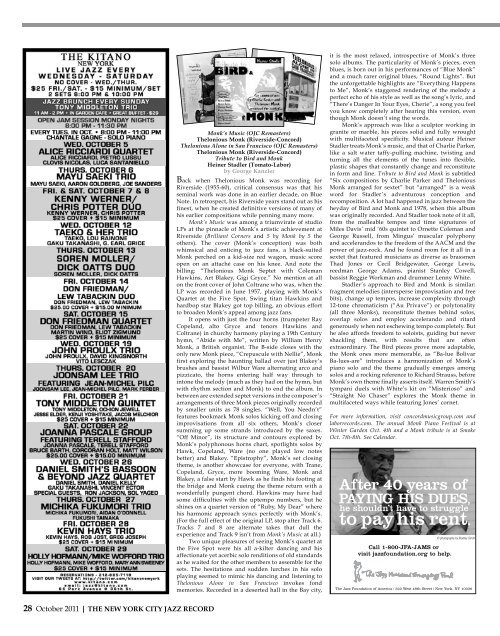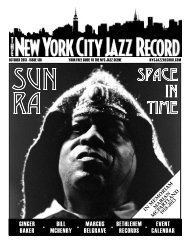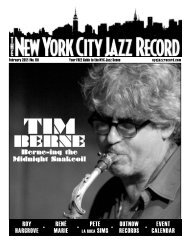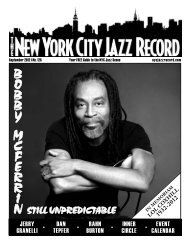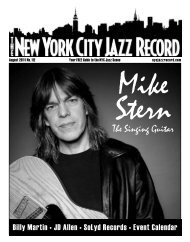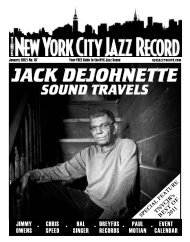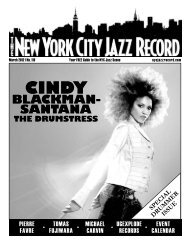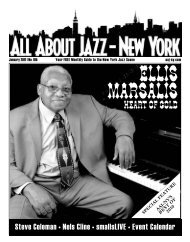Return of the Guitar Man - The New York City Jazz Record
Return of the Guitar Man - The New York City Jazz Record
Return of the Guitar Man - The New York City Jazz Record
You also want an ePaper? Increase the reach of your titles
YUMPU automatically turns print PDFs into web optimized ePapers that Google loves.
28 October 2011 | THE NEW YORK CITY JAZZ RECORD<br />
Monk’s Music (OJC Remasters)<br />
<strong>The</strong>lonious Monk (Riverside-Concord)<br />
<strong>The</strong>lonious Alone in San Francisco (OJC Remasters)<br />
<strong>The</strong>lonious Monk (Riverside-Concord)<br />
Tribute to Bird and Monk<br />
Heiner Stadler (Tomato-Labor)<br />
by George Kanzler<br />
Back when <strong>The</strong>lonious Monk was recording for<br />
Riverside (1955-60), critical consensus was that his<br />
seminal work was done in an earlier decade, on Blue<br />
Note. In retrospect, his Riverside years stand out as his<br />
finest, when he created definitive versions <strong>of</strong> many <strong>of</strong><br />
his earlier compositions while penning many more.<br />
Monk’s Music was among a triumvirate <strong>of</strong> studio<br />
LPs at <strong>the</strong> pinnacle <strong>of</strong> Monk’s artistic achievement at<br />
Riverside (Brilliant Corners and 5 by Monk by 5 <strong>the</strong><br />
o<strong>the</strong>rs). <strong>The</strong> cover (Monk’s conception) was both<br />
whimsical and enticing to jazz fans, a black-suited<br />
Monk perched on a kid-size red wagon, music score<br />
open on an attaché case on his knee. And note <strong>the</strong><br />
billing: “<strong>The</strong>lonious Monk Septet with Coleman<br />
Hawkins, Art Blakey, Gigi Gryce.” No mention at all<br />
on <strong>the</strong> front cover <strong>of</strong> John Coltrane who was, when <strong>the</strong><br />
LP was recorded in June 1957, playing with Monk’s<br />
Quartet at <strong>the</strong> Five Spot. Swing titan Hawkins and<br />
hardbop star Blakey got top billing, an obvious effort<br />
to broaden Monk’s appeal among jazz fans.<br />
It opens with just <strong>the</strong> four horns (trumpeter Ray<br />
Copeland, alto Gryce and tenors Hawkins and<br />
Coltrane) in churchy harmony playing a 19th Century<br />
hymn, “Abide with Me”, written by William Henry<br />
Monk, a British organist. <strong>The</strong> B-side closes with <strong>the</strong><br />
only new Monk piece, “Crepuscule with Nellie”, Monk<br />
first exploring <strong>the</strong> haunting ballad over just Blakey’s<br />
brushes and bassist Wilbur Ware alternating arco and<br />
pizzicato, <strong>the</strong> horns entering half way through to<br />
intone <strong>the</strong> melody (much as <strong>the</strong>y had on <strong>the</strong> hymn, but<br />
with rhythm section and Monk) to end <strong>the</strong> album. In<br />
between are extended septet versions in <strong>the</strong> composer’s<br />
arrangements <strong>of</strong> three Monk pieces originally recorded<br />
by smaller units as 78 singles. “Well, You Needn’t”<br />
features bookmark Monk solos kicking <strong>of</strong>f and closing<br />
improvisations from all six o<strong>the</strong>rs, Monk’s closer<br />
summing up some strands introduced by <strong>the</strong> saxes.<br />
“Off Minor”, its structure and contours explored by<br />
Monk’s polyphonous horns chart, spotlights solos by<br />
Hawk, Copeland, Ware (no one played low notes<br />
better) and Blakey. “Epistrophy”, Monk’s set closing<br />
<strong>the</strong>me, is ano<strong>the</strong>r showcase for everyone, with Trane,<br />
Copeland, Gryce, more booming Ware, Monk and<br />
Blakey, a false start by Hawk as he finds his footing at<br />
<strong>the</strong> bridge and Monk cueing <strong>the</strong> <strong>the</strong>me return with a<br />
wonderfully pungent chord. Hawkins may have had<br />
some difficulties with <strong>the</strong> uptempo numbers, but he<br />
shines on a quartet version <strong>of</strong> “Ruby, My Dear” where<br />
his harmonic approach syncs perfectly with Monk’s.<br />
(For <strong>the</strong> full effect <strong>of</strong> <strong>the</strong> original LP, stop after Track 6.<br />
Tracks 7 and 8 are alternate takes that dull <strong>the</strong><br />
experience and Track 9 isn’t from Monk’s Music at all.)<br />
Two unique pleasures <strong>of</strong> seeing Monk’s quartet at<br />
<strong>the</strong> Five Spot were his all a-kilter dancing and his<br />
affectionate yet acerbic solo renditions <strong>of</strong> old standards<br />
as he waited for <strong>the</strong> o<strong>the</strong>r members to assemble for <strong>the</strong><br />
sets. <strong>The</strong> hesitations and sudden lurches in his solo<br />
playing seemed to mimic his dancing and listening to<br />
<strong>The</strong>lonious Alone in San Francisco invokes fond<br />
memories. <strong>Record</strong>ed in a deserted hall in <strong>the</strong> Bay city,<br />
it is <strong>the</strong> most relaxed, introspective <strong>of</strong> Monk’s three<br />
solo albums. <strong>The</strong> particularity <strong>of</strong> Monk’s pieces, even<br />
blues, is born out in his performances <strong>of</strong> “Blue Monk”<br />
and a much rarer original blues, “Round Lights”. But<br />
<strong>the</strong> unforgettable highlights are “Everything Happens<br />
to Me”, Monk’s staggered rendering <strong>of</strong> <strong>the</strong> melody a<br />
perfect echo <strong>of</strong> his style as well as <strong>the</strong> song’s lyric, and<br />
“<strong>The</strong>re’s Danger In Your Eyes, Cherie”, a song you feel<br />
you know completely after hearing this version, even<br />
though Monk doesn’t sing <strong>the</strong> words.<br />
Monk’s approach was like a sculptor working in<br />
granite or marble, his pieces solid and fully wrought<br />
with multifaceted specificity. Musical auteur Heiner<br />
Stadler treats Monk’s music, and that <strong>of</strong> Charlie Parker,<br />
like a salt water taffy-pulling machine, twisting and<br />
turning all <strong>the</strong> elements <strong>of</strong> <strong>the</strong> tunes into flexible,<br />
plastic shapes that constantly change and reconstitute<br />
in form and line. Tribute to Bird and Monk is subtitled<br />
“Six compositions by Charlie Parker and <strong>The</strong>lonious<br />
Monk arranged for sextet” but “arranged” is a weak<br />
word for Stadler’s adventurous conception and<br />
recomposition. A lot had happened in jazz between <strong>the</strong><br />
heyday <strong>of</strong> Bird and Monk and 1978, when this album<br />
was originally recorded. And Stadler took note <strong>of</strong> it all,<br />
from <strong>the</strong> malleable tempos and time signatures <strong>of</strong><br />
Miles Davis’ mid ‘60s quintet to Ornette Coleman and<br />
George Russell, from Mingus’ muscular polyphony<br />
and accelerandos to <strong>the</strong> freedom <strong>of</strong> <strong>the</strong> AACM and <strong>the</strong><br />
power <strong>of</strong> jazz-rock. And he found room for it all in a<br />
sextet that featured musicians as diverse as brassmen<br />
Thad Jones or Cecil Bridgewater, George Lewis,<br />
reedman George Adams, pianist Stanley Cowell,<br />
bassist Reggie Workman and drummer Lenny White.<br />
Stadler’s approach to Bird and Monk is similar:<br />
fragment melodies (intersperse improvisation and free<br />
bits), change up tempos, increase complexity through<br />
12-tone chromaticism (“Au Privave”) or polytonality<br />
(all three Monks), reconstitute <strong>the</strong>mes behind solos,<br />
overlap solos and employ accelerando and ritard<br />
generously when not eschewing tempo completely. But<br />
he also affords freedom to soloists, guiding but never<br />
shackling <strong>the</strong>m, with results that are <strong>of</strong>ten<br />
extraordinary. <strong>The</strong> Bird pieces prove more adaptable,<br />
<strong>the</strong> Monk ones more memorable, as “Ba-lue Bolivar<br />
Ba-lues-are” introduces a harmonization <strong>of</strong> Monk’s<br />
piano solo and <strong>the</strong> <strong>the</strong>me gradually emerges among<br />
solos and a rocking reference to Richard Strauss, before<br />
Monk’s own <strong>the</strong>me finally asserts itself. Warren Smith’s<br />
tympani duels with White’s kit on “Misterioso” and<br />
“Straight No Chaser” explores <strong>the</strong> Monk <strong>the</strong>me in<br />
multifaceted ways while featuring Jones’ cornet.<br />
For more information, visit concordmusicgroup.com and<br />
laborrecords.com. <strong>The</strong> annual Monk Piano Festival is at<br />
Winter Garden Oct. 4th and a Monk tribute is at Smoke<br />
Oct. 7th-8th. See Calendar.<br />
After 40 years <strong>of</strong><br />
PAYING HIS DUES<br />
he shouldn’t have to struggle<br />
to payhis rent<br />
Call 1-800-JFA-JAMS or<br />
visit jazzfoundation.org to help.<br />
,<br />
.<br />
© photography by Bradley Smith.<br />
<strong>The</strong> <strong>Jazz</strong> Foundation <strong>of</strong> America / 322 West 48th Street / <strong>New</strong> <strong>York</strong>, NY 10036


